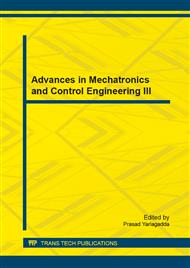[1]
Andrews A., Offutt J. and Alexander R. (2005) Testing Web Applications by Modeling with FSMs. Journal of Software and Systems Modeling, vol. 4: 326-345, Springer-verlag (2005).
DOI: 10.1007/s10270-004-0077-7
Google Scholar
[2]
Chang W-K. and Jeng S-L. (2005). Impartial evaluation in software reliability practice. Journal of Systems and Software, 76(2): 99-110, Elsevier Science Inc. New York, NY, USA (2005).
DOI: 10.1016/j.jss.2004.03.029
Google Scholar
[3]
Swiderski F, Snyder W. Threat Modeling. Microsoft Press: Redmond, WA, (2004).
Google Scholar
[4]
Hamlet, D. (2006). When Only Random Testing Will Do. Proceedings of the First International Workshop on Random Testing (RT'06), July 20, 2006, Portland, ME, USA, ACM Publ.
DOI: 10.1145/1145735.1145737
Google Scholar
[5]
Fonseca, J. and Vieira, M. and Madeira, H. (2007).
Google Scholar
[6]
Huang Y-W., Yu F., Hang C., Tsai C-H, Lee D-T. and Kuo S-Y. (2004). Securing web application code by static analysis and runtime protection. Proceedings of WWW 2004, pp.40-52, ACM publ.
DOI: 10.1145/988672.988679
Google Scholar
[7]
Lyu M.R. (2007). Software Reliability Engineering: A Roadmap. Proceedings of Future of Software Engineering, 2007. FOSE '07 (2007), pp.153-170.
DOI: 10.1109/fose.2007.24
Google Scholar
[8]
Qi, Y., Kung, D. and Wong, E. (2005). An agent-based testing approach for Web applications. Proceedings of 29th Annual International Computer Software and Applications Conference (COMPSAC 2005). 26-28 July 2005, pp.45-50, IEEE Comp Society Publ.
DOI: 10.1109/compsac.2005.42
Google Scholar
[9]
Ricca F. and Tonella P. (2005). Web Testing: a Roadmap for the Empirical Research. Proceedings of the International Symposium on Web Site Evolution (WSE) 2005. Damiano Distante (ed. ): pp.63-70. September, 2005. IEEE Computer Society.
DOI: 10.1109/wse.2005.23
Google Scholar
[10]
Tonella P. and Riccs F. (2004). Statistical testing of Web applications. Journal of Software Maintenance, 16(1-2): 103-127 (2004).
Google Scholar
[11]
Walton G.H. and Poore J.H. (2000). Generating transition probabilities to support model-based software testing. Journal Software—Practice & Experience, 30(10): 1095 – 1106, John-Wiley & Sons Inc., New York, NY, USA.
DOI: 10.1002/1097-024x(200008)30:10<1095::aid-spe328>3.0.co;2-h
Google Scholar
[12]
Scott, D., Sharp, R. Abstracting Application-Level Web Security. " In: Proc. 11th Int, l Conf. World Wide Web (WWW2002), pages 396-407, Honolulu, Hawaii, May 17-22, (2002).
DOI: 10.1145/511446.511498
Google Scholar
[13]
Scott, D., Sharp, R. Developing Secure Web Applications., IEEE Internet Computing, 6(6), 38-45, Nov (2002).
DOI: 10.1109/mic.2002.1067735
Google Scholar
[14]
Chang, W.K., Twu, S., Teng, W., 1999. Ensuring functional test coverage for avionics control applications through statistical usage testing. In: FESMA'99, 2nd European Software Measurement Conference, 4–8 October 1999, Amsterdam, The Netherlands. p.261.
Google Scholar


